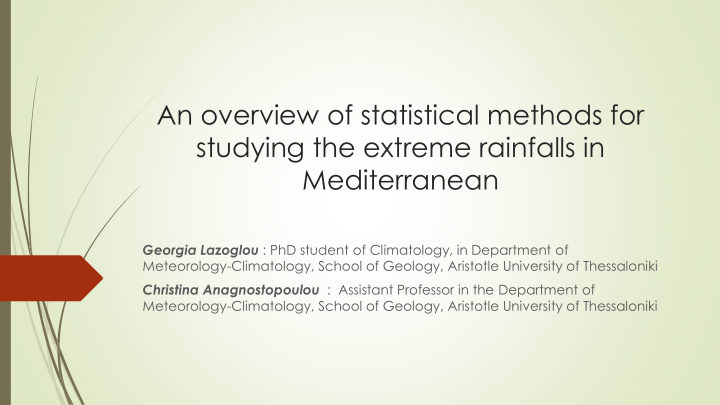



An overview of statistical methods for studying the extreme rainfalls in Mediterranean Georgia Lazoglou : PhD student of Climatology, in Department of Meteorology-Climatology, School of Geology, Aristotle University of Thessaloniki Christina Anagnostopoulou : Assistant Professor in the Department of Meteorology-Climatology, School of Geology, Aristotle University of Thessaloniki
Introduction The last decades the frequency and the intensity of the extreme rainfall events in the Mediterranean region has been increased. This change has serious impacts in many fields such as agriculture, economy etc. The science tries to investigate the extremes behavior with some statistical tools. The most common is the Extreme Value Theory (EVT). The main purpose of this study is to evaluate some of the most commonly used statistical methods and techniques that are used for the analysis of the extreme precipitation events in the Mediterranean region. Moreover it offers a measurement of the rainfall risk for the Mediterranean stations through the return levels.
Data This study uses daily values of precipitation from 10 Mediterranean stations. The values cover the period from 1951 to 2010.
Methodology The extreme precipitations were chosen for each station, using the Block Maxima and the Peaks Over Threshold (POT) techniques. The Block Maxima was applied on annual sub-periods. For POT, the precipitation events with amounts higher than 99% were chosen as extremes. The GEV and the Pareto distributions were fitted on the new data sets with the extreme values. For finding the shape, scale and the location of the distributions, three estimation methods were used and evaluated: the Maximum Likelihood estimation method (MLE), the L-moments method and the Bayesian method. * Each method is named with the combination of the distribution and the estimation method. For example the GEV-B describes the GEV distribution with the Bayesian estimation method.
Results (Station’s Climatology) STATIONS PRECIPITATION Absolute Mean daily Name Country maximum (mm) Gospic is the station with the (mm) highest mean daily precipitation, Malaga Spain 1.55 313 while Malaga has the highest Barcelona Spain 1.72 194.8 absolute maximum amount. Nice France 2.2 191.4 The absolute maximum rainfall Bastia France 2.12 232.4 amount was record in Malaga , Cagliari Italy 1.14 109.6 whereas the minimum in Thessaloniki . Verona Villa Italy 2.17 198 Franca The mean daily precipitation is not related with the absolute Gospic Croatia 3.79 141 maximum amount. Split Marjan Croatia 2.23 131.6 Athens Greece 1.09 116 Thessaloniki Greece 1.24 98
Results (Shape Diagram) Shape parameter can be considered as one of the most appropriate method for checking the distribution fit. For precipitation a distribution with an upper threshold is not appropriate. Weibull distribution (positive shape), is inappropriate for the parameter of precipitation, while Frechet (negative shape), can describe rainfalls. GEV-L does not fit accurately the extreme rainfalls in the majority of stations. Shape parameter-Precipitation 0.3 0.2 0.1 0.0 Malaga Barcelona Nice Cagliari Bastia Verona Villa Gospic Split Athens Thessalonikh Franca -0.1 -0.2 GEV-M GEV-L GEV-B GPD-M GPD-L GPD-B
Results (QQ plots) QQ plots is another test for the evaluation of the assumed distributions. Both GEV and GPD can characterize satisfactorily the extreme rainfalls in the majority of the stations. GPD-M, GPD-L and GPD-B methods are more appropriate for small and medium rainfall value. For more extreme values both GEV-B and GPD-B distributions are appropriate in almost all stations. The QQ plot of only one station (Athens) is presented.
Results (Return Levels) The return levels were estimated for three return periods (50,100,150 years), using all the estimation methods and studied distributions. For the three return periods, Bastia presents the highest return levels while Thessaloniki the lowest. Bayesian method with both GPD and GEV distributions gives the highest return levels. In the western Mediterranean and in the stations with the highest altitude, the greatest precipitation return levels are recorded with the GEV-B while for the eastern stations with the GPD-B. The GPD-M or GPD-L methods present the lowest return values for the western stations, while the GEV-M for the eastern ones.
Conclusions The choice of the most appropriate distribution for a data set is difficult and can affect the final results. Based on statistical and graphical tests (goodness of fit tests, shape diagram, QQ plots), GEV,GPD distributions and three estimation methods were evaluated. The GPD method (with MLE, L-moments and Bayesian) could characterize sufficiently the minimum and medium extreme values. The Bayesian estimated method with both GEV and GPD distribution is the most suitable method for fitting the maximum extreme rainfalls. The less suitable estimated method for the extreme rainfalls in Mediterranean is GEV-L.
Conclusions The Bayesian method gives the highest return levels in Mediterranean, GEV-B method for the western Mediterranean stations (Malaga and Barcelona) and GPD-B for the eastern Mediterranean stations (Athens and Thessaloniki).
Recommend
More recommend